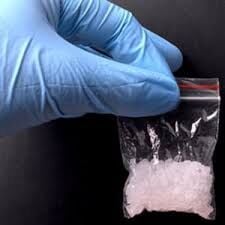BURLINGTON – There are a variety of illegal narcotic substances out on the streets in Burlington but the most common are marijuana and methamphetamine.
Narcotic types and investigation procedures were topics at the Burlington Police Department’s Citizens Police Academy Tuesday night.
Southeast Iowa Narcotics Task Force agents Jacob Jenkins, a detective with the Burlington Police Department said it’s a war the task force and local police battle daily that will probably never be won.
Jenkins was joined by Cody Schlueter, a fellow task force member and an officer with the West Burlington Police Department, for a presentation about narcotics and law enforcement.
Schlueter said the legalization of recreational marijuana use in states bordering Iowa has not ramped up arrests for the substance here. Its prevalence in Burlington has more to do with the low cost and available supply.
The same reasons methamphetamine is common here – a ready supply at an affordable price.
However, meth production has changed largely due to Iowa’s precursor laws that make it a risk to purchase products that are commonly used in meth production – mainly pseudoephedrine – an over-the-counter medicine that eases symptoms of the common cold.
Homemade meth isn’t common in this area anymore and a lot of that is due to the precursor laws Iowa has on the books.
“One law created another problem,” Schlueter said.
Jenkins said 85-90% of the meth sold locally comes directly from Mexican drug cartel super labs. “It’s insane the amount coming across the border,” Jenkins said.
Jenkins said he doesn’t know why it’s so cheap here, but the supply and the price make the southeast Iowa area a hot market for surrounding communities in Iowa and Illinois to come here for purchases.
The drug, which is almost immediately addicting, allows for the release of a high level of dopamine, a chemical that acts on areas of the brain to give you feelings of pleasure, satisfaction and motivation. Dopamine also has a role to play in controlling memory, mood, sleep, learning, concentration, movement and other body functions.
Jenkins said a meth user will have days with a lot of activity and can go a long time without sleep, but that will often be followed by a solid two to three days of sleep. “And they aren’t doing anything but sleeping for two to three days straight. They aren’t using the bathroom – they aren’t eating,” Jenkins said.
Meth came on the scene during World War II. It was used by German soldiers to stay awake for battle.
Heroin cut with fentanyl has become an issue locally and has led to a spike in overdose and overdose deaths.
Schlueter said it is common for a dealer to have an ounce of heroine that they will cut with baking soda and some fentanyl. “Now they have two ounces they can sell and make even more money on,” Schlueter said.
The problem for the user is the addition of fentanyl, which is lethal at very concentrated amounts. “This stuff isn’t being put together in a regulated laboratory. It’s in someone’s basement or on their coffee table,” Schlueter said. Users play a game of Russian roulette with every purchase because it is unknown just how much fentanyl is contained in a dose of heroine.
Jenkins said of all the drug users he has interviewed; heroin users display the most shame concerning their use of the drug. Some of that is due to how they became addicted in the first place.
Often, these are people have a medical condition that they have been dealing with for many years, and their doctor has cut off their supply of legally prescribed pain medication. But the physical pain persists for them. Heroin takes that pain away Jenkins said.
Heroin drug cases represent the task forces’ biggest chance to get a drug conviction in a federal court of law, which means the offender is more likely to serve most of their sentence. “If you have 50-plus grams of heroin with at least 90% purity, federally you are going to do 10 years (in prison),” Jenkins said.
Southeast Iowa has been aided in years past by the US Marshall Service and the FBI in efforts to combat drug trafficking. Jenkins said that assistance has done a lot for local law enforcement in its efforts. However, certain activities are on the rise locally and a lot of that is due to a decrease in the availability of agents to assist here like in years past, Jenkins said.
Jenkins said the law may be coming around with a tool to assist drug trafficking. A charge of drug induced homicide could result in culpability to those who supply others with drugs. “I think we will be seeing that before long,” Jenkins said.
The wide availability of narcan and naloxone, which if administered quickly can prevent an accidental overdose death, has helped lessen that number. “When fentanyl first hit the streets, we had multiple incidents per week,” Jenkins said.
The task force will occasionally see crack cocaine and cocaine, but the cost of those drugs makes it scarce. They also deal with party drugs like ecstasy (MDMA), psylocybin mushrooms which are hallucinogens and something new made from the bark of a tree found in Central and South American – DMT dimethyltryptamine.
Schlueter said you can find directions for producing DMT from the tree bark on YouTube, and it isn’t illegal to have the bark. Schlueter said the task force has found the bark and the drug more recently in southeast Iowa.
The Burlington Police Department has conducted its Citizens Academy for the past 21 years. The class of about 15 citizens are given a peek into the operations and work experiences of the BPD officers and the issues they face on the job.
There are two more academy sessions, and each participant will get a chance to ride along with a patrol officer during a shift.







